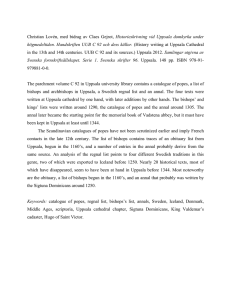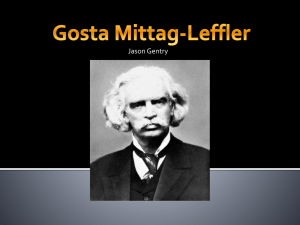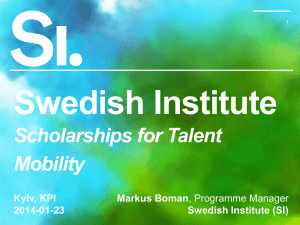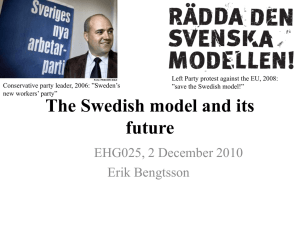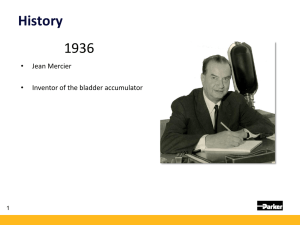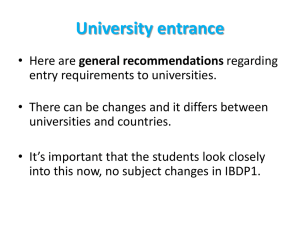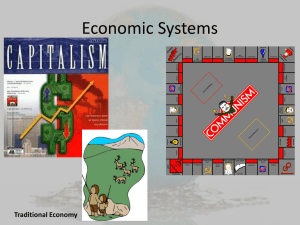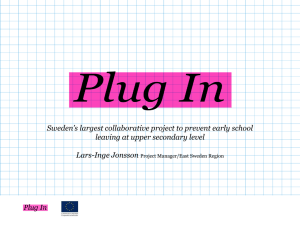Curriculum Vitae for Katrin Lundstedt-Enkel
advertisement
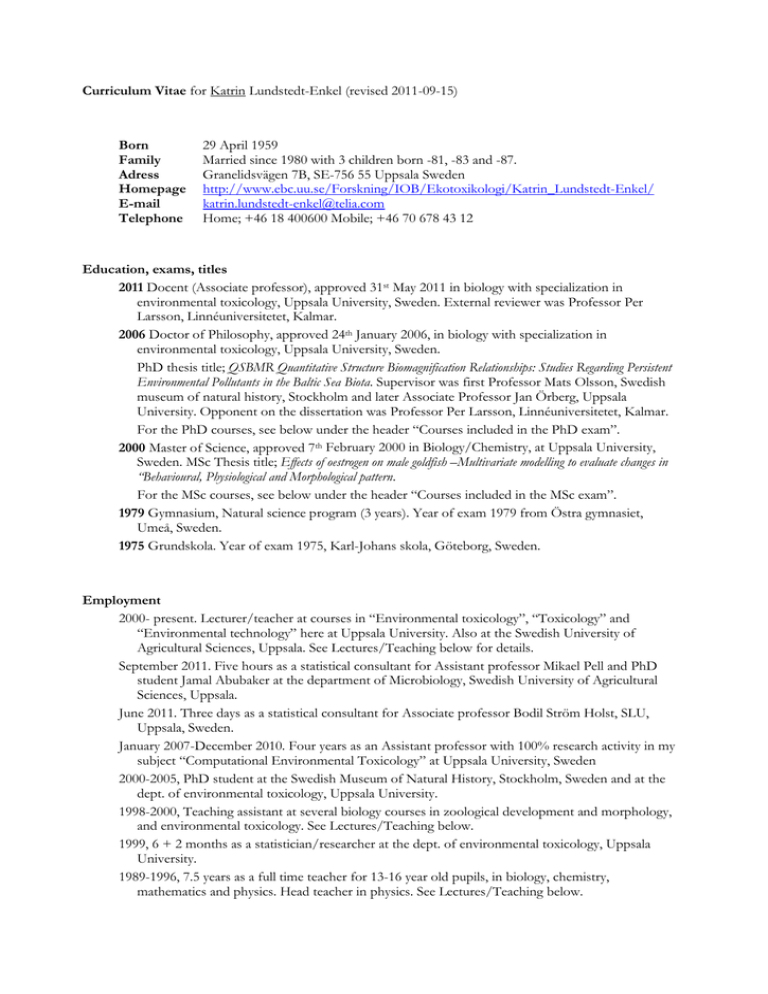
Curriculum Vitae for Katrin Lundstedt-Enkel (revised 2011-09-15) Born Family Adress Homepage E-mail Telephone 29 April 1959 Married since 1980 with 3 children born -81, -83 and -87. Granelidsvägen 7B, SE-756 55 Uppsala Sweden http://www.ebc.uu.se/Forskning/IOB/Ekotoxikologi/Katrin_Lundstedt-Enkel/ katrin.lundstedt-enkel@telia.com Home; +46 18 400600 Mobile; +46 70 678 43 12 Education, exams, titles 2011 Docent (Associate professor), approved 31st May 2011 in biology with specialization in environmental toxicology, Uppsala University, Sweden. External reviewer was Professor Per Larsson, Linnéuniversitetet, Kalmar. 2006 Doctor of Philosophy, approved 24th January 2006, in biology with specialization in environmental toxicology, Uppsala University, Sweden. PhD thesis title; QSBMR Quantitative Structure Biomagnification Relationships: Studies Regarding Persistent Environmental Pollutants in the Baltic Sea Biota. Supervisor was first Professor Mats Olsson, Swedish museum of natural history, Stockholm and later Associate Professor Jan Örberg, Uppsala University. Opponent on the dissertation was Professor Per Larsson, Linnéuniversitetet, Kalmar. For the PhD courses, see below under the header “Courses included in the PhD exam”. 2000 Master of Science, approved 7th February 2000 in Biology/Chemistry, at Uppsala University, Sweden. MSc Thesis title; Effects of oestrogen on male goldfish –Multivariate modelling to evaluate changes in “Behavioural, Physiological and Morphological pattern. For the MSc courses, see below under the header “Courses included in the MSc exam”. 1979 Gymnasium, Natural science program (3 years). Year of exam 1979 from Östra gymnasiet, Umeå, Sweden. 1975 Grundskola. Year of exam 1975, Karl-Johans skola, Göteborg, Sweden. Employment 2000- present. Lecturer/teacher at courses in “Environmental toxicology”, “Toxicology” and “Environmental technology” here at Uppsala University. Also at the Swedish University of Agricultural Sciences, Uppsala. See Lectures/Teaching below for details. September 2011. Five hours as a statistical consultant for Assistant professor Mikael Pell and PhD student Jamal Abubaker at the department of Microbiology, Swedish University of Agricultural Sciences, Uppsala. June 2011. Three days as a statistical consultant for Associate professor Bodil Ström Holst, SLU, Uppsala, Sweden. January 2007-December 2010. Four years as an Assistant professor with 100% research activity in my subject “Computational Environmental Toxicology” at Uppsala University, Sweden 2000-2005, PhD student at the Swedish Museum of Natural History, Stockholm, Sweden and at the dept. of environmental toxicology, Uppsala University. 1998-2000, Teaching assistant at several biology courses in zoological development and morphology, and environmental toxicology. See Lectures/Teaching below. 1999, 6 + 2 months as a statistician/researcher at the dept. of environmental toxicology, Uppsala University. 1989-1996, 7.5 years as a full time teacher for 13-16 year old pupils, in biology, chemistry, mathematics and physics. Head teacher in physics. See Lectures/Teaching below. 1984-1987, 3 years (night shift) as a nursing auxiliary, Umeå Regional Hospital, and at a nursing home at Shetland Isles, UK during 6 weeks. 1976-1987, 11 years (on Saturdays, holidays and summers) as an assistant mail-man, Umeå, Sweden. Articles in peer reviewed Journals Dahlbom S J, Lagman D, Lundstedt-Enkel K, Sundström F, Winberg S. 2011. Boldness predicts social status in zebrafish (Danio rerio). PLoS One. 2011; 6(8): e23565. doi: 10.1371 Lundstedt-Enkel K. 2011. Comments on "Levels of PCDD/F and dioxin-like PCB in Baltic fish of different age and gender" by M. Pandelova, B. Henkelmann, O. Roots, M. Simm, L. Järv, E. Benfenati, K.-W. Schramm [Chemosphere 71(2) (2008) 369-378]. Chemosphere 82(5):786 Lundstedt-Enkel K, Bjerselius R, Asplund L, Nylund K, Liu Y, and Södervall M. 2010. Modelling relationships between Baltic Sea herring (Clupea harengus) biology and contaminant concentrations using Multivariate Data Analysis. Environmental Science and Technology 44(23): 9018-9023. Lundstedt-Enkel K, Karlsson D and Darnerud PO. 2010. Interaction study with rats given two flame retardants; polybrominated diphenyl ethers (Bromkal 70-5 DE) and chlorinated paraffins (Cereclor 70L). Journal of Chemometrics 24(11-12):710-718 Andersson C, Lundstedt-Enkel K, Katsiadaki I, Holt WV, Van Look KJW and Örberg J. 2010. A chemometrical approach to study interactions between ethynylestradiol and an AhR-agonist in stickleback (Gasterosteus aculeatus). Journal of Chemometrics 24(11-12):768-778 Sobek A, McLachlan MS, Borgå K, Asplund L, Lundstedt-Enkel K, Polder A, and Gustafsson Ö. 2010. A comparison of PCB bioaccumulation factors between an arctic and a temperate marine food web. Science of the Total Environment 408(13):2753-2760 Lundstedt T, Lundstedt-Enkel K, Gottfries J and Trygg J. 2009. Editorial. 17th European Symposium on QSAR 2008. QSAR and Combinatorial Science 28(8):779 Brunelli E, Bernabò I, Berg C, Lundstedt-Enkel K, Bonacci A, and Tripepi S. 2009. Environmentally relevant concentrations of endosulfan impair development, metamorphosis and behaviour in Bufo bufo tadpoles. Aquatic toxicology 91(2):135-142. Andersson, C., Katsiadaki, I., Lundstedt-Enkel, K. and Örberg, J. 2007. Effects of 17αethynylestradiol on EROD activity, spiggin and vitellogenin in three-spined stickleback (Gasterosteus aculeatus). Aquatic toxicology 83(1):33-42. Lundstedt-Enkel K., Lek P., Lundstedt T. and Örberg J. 2007. QSBMR - Quantitative structure biomagnification relationships: physicochemical and structural descriptors important for the biomagnification of organochlorines and brominated flame retardants. Journal of Chemometrics 20:392-401. Lundstedt-Enkel, K., Asplund, L., Nylund, K., Bignert, A., Tysklind, M., Olsson, M. and Örberg, J. 2006. Multivariate data analysis of organochlorines and brominated flame retardants in Baltic Sea guillemot (Uria aalge) egg and muscle. Chemosphere 65:1591-1599. Pettersson, I., Arukwe, A., Lundstedt-Enkel, K., Mortensen, A.S. and Berg, C. 2006. Persistent sexreversal and oviducal agenesis in adult Xenopus (Silurana) tropicalis frogs following larval exposure to the environmental pollutant ethynylestradiol. Aquatic Toxicology 79(4):356-365. Lundstedt-Enkel, K., Gabrielsson J., Olsman H., Seifert E., Pettersen J., Lek P.M., Boman A. and Lundstedt T. 2006 Different multivariate approaches to material discovery, process development, PAT and environmental process monitoring. Chemometrics and Intelligent Laboratory Systems 84:201– 207. Lundstedt-Enkel K., Johansson A.-K., Asplund L., Nylund K., Olsson M., Tysklind M. and Örberg J. 2005. Multivariate data analyses of chlorinated and brominated contaminants and biological characteristics in adult guillemot (Uria aalge) from the Baltic Sea. Environmental Science and Technology 39(22):8630-8637. Lundstedt-Enkel, K., Tysklind, M., Trygg, J., Schüller, P., Asplund, L., Eriksson, U., Häggberg, L., Odsjö, T., Hjelmberg, M., Olsson, M., Örberg, J. 2005. A statistical resampling method to calculate biomagnification factors exemplified with organochlorine data from herring (Clupea harengus) muscle and guillemot (Uria aalge) egg from the Baltic Sea. Environmental Science and Technology 39(21):8395-8402. Bjerselius, R.; Lundstedt-Enkel, K.; Olsen, H.; Mayer, I.; Dimberg, K. 2001. Male goldfish reproductive behaviour and physiology are severely affected by exogenous exposure to 17 betaestradiol. Aquatic Toxicology 53(2):139-152. Manuscripts near completion Dahlbom S J, Backström T, Ismail H, Lundstedt-Enkel K, Winberg S. 2011. Relationship between the function of the serotonergic system and social rank in zebrafish (Danio rerio). Submission 2011. Lundstedt-Enkel K, Roos A, Nylund K, Asplund L and Burgos J. Computational environmental toxicology: Modelling animal biology and contaminant concentrations in grey seals (Halichoerus grypus) from the Baltic Sea. Submission 2011. Lundstedt-Enkel K, Halldin-Ankarberg E, Aune M, Bjerselius R, Nylund K and Asplund L. Computational environmental toxicology: Modelling fish biology and contaminant concentrations in salmon (Salmo salar) from the Baltic Sea. Submission 2011. Publications in peer reviewed Conference Proceedings Lundstedt-Enkel K. Multivariate methods used during the multivariate research chain – from design of experiments to data evaluation. Reproduction in wild vertebrates, CRU, Report no. 25, SLU, Uppsala, 2011. pp. 25-26. Lundstedt T, Moritz T, Madsen R, Lundstedt-Enkel K and Trygg J. Endogenous metabolic profiling as a tool in drug discovery. 7th annual global conference on Neuroprotection and Neuroregeneration 2010, Stockholm, Sweden. pp. 25. Lundstedt-Enkel K, Lek PM, Lundstedt T and Örberg J. Computational ecotoxicology to predict biomagnification of contaminants. EuroQSAR 2008, Uppsala, Sweden. 2 pages Lundstedt-Enkel K, Lek P M, Lundstedt T, and Örberg J. Computational ecotoxicology; Modelling the biomagnification of organochlorines and brominated flame retardants in a Baltic Sea food web. Organohalogen compounds 2008, 70, pp. 442-444. Lundstedt-Enkel K, Roos A, Nylund K and Asplund L. Contaminants in Baltic Sea male and female grey seals (Halichoerus grypus) of different ages. Organohalogen compounds 2008, 70, pp. 829-832. Lundstedt T., Lek P.M., Lundstedt-Enkel K., Seifert E., Boman A and Trygg J. The use of Focused hierarchical experimental design (F-HDOE) and OPLS in development of biological active compounds. IMMPC-3, 3rd International Meeting on Medicinal and Pharmaceutical Chemistry, 2007. 1 page. Lundstedt-Enkel K., Lek P.M., Lundstedt T. and Örberg J. Relationships between physicochemical and structural descriptors and biomagnification of organochlorines and brominated flame retardants. Fourth International Workshop on Brominated Flame Retardants, BFR 2007, 4 pages. Ankarberg, A., Bjerselius, R., Aune, M., Darnerud, P-O., Larsson, L., Andersson, A., Tysklind, M., Bergek, S., Lundstedt-Enkel, K., Karlsson, L., Törnkvist, A. and Glynn, A. Study of dioxin and dioxin-like PCB levels in fatty fish from Sweden 2000-2002. Organohalogen compounds, 2004, 66, pp. 2061-2065. Bjerselius R., Aune M., Darnerud P O, Andersson A, Tysklind M, Bergek S, Lundstedt-Enkel K, Karlsson L, Appelberg M, Arrhenius F, Wickström H and Glynn A. Study of dioxin levels in fatty fish from Sweden 2001- 2002 Part II. Organohalogen compounds, 2003, 62, pp. 193-196. Lundstedt-Enkel, K., Bjerselius, R., Aune, M., Darnerud, P-O. Atuma, S., Tysklind, M., Bergek, S., Karlsson, L., Appelberg, M. and Glynn, A. Different PCDD/PCDF congener composition in Salmon and Brown trout from Swedish waters. Organohalogen compounds, 2002, 57, pp. 185-188. Bjerselius, R., Aune, M., Darnerud, P-O. Atuma, S., Tysklind, M., Bergek, S., Lundstedt-Enkel, K., Karlsson, L., Appelberg, M. and Glynn, A. Study of dioxin levels in fatty fish from Sweden 2000 – 2001. Organohalogen compounds, 2002, 57, pp. 189-192. Bjerselius, R., Aune, M., Darnerud, P-O. Atuma, S., Tysklind, M., Bergek, S., Lundstedt-Enkel, K., Karlsson, L., Appelberg, M. and Glynn, A. PCDD/PCDF contribute with half of the total TEQ found in fatty fish from the Baltic sea. Organohalogen compounds, 2002, 57, pp. 209-212. Lundstedt-Enkel, K.; Sellström, U.; Häggberg, L.; de Wit, C.; Örberg, J.; Olsson, M. Concentrations of BDE-47, BDE-99, BDE-100, BDE-153, BDE-154 and HBCDD in guillemot egg from the Baltic proper 1996-2000, Second International Workshop on Brominated Flame-Retardants, BFR 2001, 46, pp. 341-343. Lundstedt-Enkel, K.; Sellström, U.; Häggberg, L.; de Wit, C.; Örberg, J.; Olsson, M. Multivariate modelling of concentrations of BDE-47, BDE-99, BDE-100 and HBCDD in relation to organochlorines in guillemot egg collected from the Baltic proper 1996-2000, Second International Workshop on Brominated Flame Retardants, BFR 2001, pp. 345-348. Bjerselius, R.; Lundstedt-Enkel, K.; Olsén, K. H.; Mayer, I. Estrogen in food or water severely affect the male goldfish (Carassius auratus) sexual behaviour, 6th International Symposium on the Reproductive Physiology of Fish, 1999, pp. 388. Lundstedt-Enkel, K.; Olsén, K. H.; Bjerselius, R. Effects of oestrogen on male goldfish (Carassius auratus); Multivariate modelling to evaluate changes in "physiological-behavioural pattern", 6th International Symposium on the Reproductive Physiology of Fish, Bergen,1999, pp. 390. Other Publications, Book chapters, Reports Lundstedt-Enkel K. Editor, abstract book with more than 150 contributions for the 17th European Symposium on QSAR in “omics” and Systems biology, Uppsala, September 2008. Lundstedt-Enkel K. Environmental pollution and biology of aquatic animals. The Souvenir, Scientific foresight, 2008. Government of Bihar, India. 9 pages Lundstedt-Enkel, K. 2005. QSBMR Quantitative Structure Biomagnification Relationships: Studies Regarding Persistent Environmental Pollutants in the Baltic Sea Biota. Acta Universitatis Upsaliensis. Comprehensive Summaries of Uppsala Dissertations from the Faculty of Science and Technology 125. 60 pp. Uppsala. ISBN 91-554-6412-2. Athanasiadou, M., Marsh, G., Athanassiadis, I., Lundstedt-Enkel, K., Asplund, L., Olsson, M. and Bergman Å. 2003. ”Screening of polybrominated compounds in species from different trophic levels in the Baltic sea”. In Athanasiadou, M. ”Brominated flame retardants and related compounds in Baltic Sea wildlife”, Doctoral thesis, Dept of Environmental Chemistry, Stockholm University, 2003. ISBN 91-7265-773-1 Bjerselius, R., Aune, M., Darnerud, P-O., Atuma, S., Tysklind, M., Bergek, S., Lundstedt-Enkel, K. och Glynn, A. ”Resultat från analys av dioxin och dioxinlika PCB i fisk från Östersjön, Vänern och Vättern”. Nationellt miljögiftsseminarium 12-13 juni 2002 i Nässjö. Länsstyrelsen Jönköpings län. Meddelande 02:27. ISSN 1101-9425. ISRN LSTY-F-M--02/27-SE. pp. 48-51. In Swedish. Valters K., Olsson A., Viksne J., Lundstedt-Enkel K. and Bergman Å. 2001. Grey heron (Ardea cinerea) chicks' blood as an indicator of local exposure to organohalogen environmental contaminants. In Valters K. ”Assessment of organochlorine contamination in the aquatic environment of Latvia with perch and heron as biomarkers”. Doctoral thesis, Dept of Environmental Chemistry, Stockholm University, 2001. ISBN 91-7265-367-1. Lundstedt-Enkel, K. NewS Årsrapport 2001. En ny strategi för riskhantering av kemikalier. ”Biomagnifikation av persistenta miljögifter”. pp, 18-19. In Swedish. Lundstedt-Enkel, K. NewS Årsrapport 2000. En ny strategi för riskhantering av kemikalier. ”Miljögifter i näringskedjor” samt ”Kemikaliers egenskaper utnyttjas”. Sidor 6-7. In Swedish. Invited speaker / oral presentations /seminars Invited (1 hour) to give an “Inspirational lecturer” (inspirationsföreläsning, sv) at the course “Aquatic Ecosystems” for students in civil engineering at the Environment and Aqua techniques programme, Uppsala University. My talk given the 7th September 2011 had the title “Miljögifter i djur från Östersjöområdet- bioackumulation, biomagnifikation och effecter” (in English; “Environmental contaminants in animals from the Baltic area- bioaccumulation, biomagnification and effects”). Invited (2 hours) to the workshop “Personalities in animals and humans- The importance of studying individual differences”, Aug 30 – Sept 2, 2011, BMC, Uppsala University. My talk had the title “Multivariate methods in biological research – From experimental design to data evaluation”. Seminar (1 hour) at the department of Neuroscience, Biomedical Centre (BMC), Uppsala University in April 2011. “Multivariate methods used during the multivariate research chain- from experimental design to data evaluation”. Oral presentation (20 min) at the meeting Reproduction in wild vertebrates, SLU, Uppsala, February 2011. “Multivariate methods used during the multivariate research chain – from multivariate design to data evaluation”. Seminar presentation (1 hr) at Uppsala University, January 2010. “Experimental design, modelling and multivariate data analyses in computational environmental toxicology”. Invited speaker (1 hr) at the department of Animal Physiology, Turku University, Finland, October 2009. “Computational Ecotoxicology; Modelling, experimental design and multivariate data analysis in environmental toxicology”. Oral presentation (20 min) at the 17th Euro QSAR conference in Sweden, September 2008. “Computational ecotoxicology to predict biomagnification of contaminants.” Oral presentation (20 min) at the Dioxin 2008 conference in Birmingham, August 2008. “Contaminants in Baltic Sea male and female grey seals (Halichoerus grypus) of different ages”. Oral presentation (20 min) at the Dioxin 2008 conference in Birmingham, August 2008. “Computational Ecotoxicology; Modelling the biomagnification of organochlorines and brominated flame retardants in a Baltic Sea food web”. Invited speaker (2.5 hr) May 2008 invited by “Young Scientists” for “gymnasiestudenter” from Sweden. “Computational Ecotoxicology; Modelling of contaminant data”. Invited speaker (30 min) to the Swedish Chemical Society meeting “Chemometrics in the Uppsala Region”, 11 March 2008. ”Experimental design and multivariate data analyses in environmental toxicology”. Invited keynote speaker (1 hr) at the Sweden-India Scientists Interaction Program, 17 January 2008. Organised by the Bihar Brains Society and the Department of Science and Technology at the Patna Medical College Hospital (PMCH), Patna, Bihar, India. “Environmental pollution and biology of aquatic animals”. Invited speaker (30 min) at the course in Nature conservation, 11 May 2007 at Uppsala University. “Miljömetri; modellering av kontaminantdata från Östersjöns djur. (Environmetrics; modelling of contaminant data from Baltic Sea animals). Invited speaker (20 min) at the Baltic University Programs’ rector’s conference, 20 October 2006 in Uppsala, Sweden. “Environmental Pollutants in the Baltic Sea.” Seminar presentation (1 hr) at Uppsala University, June 2005. “Multivariate data analysis techniques, PCA, PLS and PLS-DA exemplified with data regarding the staff here at Environmental Toxicology, Uppsala University”. Invited speaker (25 min) at The Swedish Chemical Society, Chemometrics Division’s annual meeting, Tänndalen, 13-16 April 2005. “QSBMR Quantitative structure-biomagnification relationships or why do some chlorinated and brominated organic contaminants biomagnify while others do not?” Invited seminar presentation (1 hr 30 min) at ITM, Stockholm University, December 2004. “Modelling of underlying causes to the biomagnification of Chlorinated- and Brominated organic contaminants in the Baltic Sea food-web”. Presentation (10 min) at NewS-meeting October 2004. “Project 11:2 – QSBMR, Deliverables”. Invited speaker (2 hr) at “Kemi och Miljö”, Stockholm August 2004. “Environmental contaminants and QSAR – QSBMR modelling”. Seminar presentation (1 hr) at Uppsala University, June 2004. “Design of Experiments and Multivariate modelling” Presentation (30 min) at evolutionary biology centre, Uppsala University, June 2004. “Att vara doktorand” ( “To be a PhD-student”). Seminar presentation (1 hr) at Uppsala University, November 2003. “Cross validation, Bootstrapping, Jackknife or Monte Carlo?” Presentation (15 min) at evolutionary biology centre, Uppsala University, October 2003. “Being a PhD-student in Environmental toxicology”. Presentation (20 min) at NewS-meeting, October 2003. “Project 11:2 – QSBMR, Quantitative Structure – Biomagnification Relationships”. Presentation (15 min) at Swedish Chemicals Inspectorate for the Swedish (Q)SAR-network, August 2003. “Quantitative structure-biomagnification relationships for contaminants in the Baltic Sea food-web”. Presentation (30 min) at evolutionary biology centre, Uppsala University, August 2003. “To be a PhD-student in Biology”. Seminar presentation (30 min) at Uppsala University, June 2003. “Environmental toxicants in Baltic Sea animals – why Biomagnification? QSBMR!” Presentation (30 min) at NewS meeting, Örenäs slott, Skåne, September 2002. ”NewS project 3:3”. Invited presentation (1 hr) for the Expert group evaluation of the NewS project at MISTRA headquarters, Stockholm, Sweden, May 2002. ”NewS project 3:3 -Exposure” Oral presentation (20 min) at SETAC Europe 12th Annual Meeting, Vienna, Austria, May 2002. “Quantitative Structure – Biomagnification Relationship (QSBMR) models in the marine environment”. Seminar presentation (45 min) at Uppsala University, Sweden, April 2002. ”Multivariate data analysis”. Invited speaker (2.5 hrs) at KemI, National Chemicals Inspectorate, Division of Risk Assessment, February 2002. “The NewS-programme and the sub-project Exposure”. Project presentation (1 hr) at Erken, Uppsala University, December 2001. “QSBMR Quantitative Structure-Biomagnification Relationships. Modelling of organic contaminants in the Baltic Proper”. Presentation (20 min) at NewS meeting at Bjärsjöladugård, October 2001. “The NewS project III, sub-part “Exposure”. Invited speaker (30 min) at Wallenberg laboratory, Stockholm University, April 2001. “Chlorinated and brominated pollutants in Grey seal, Salmon, Guillemot and Herring from the Baltic proper. The NewS project “Exposure”, Swedish museum of Natural History and the Contaminant Research Group”. Invited speaker (2 hrs) At the Swedish National Food Administration, March, 2001. “Multivariate modelling of organic pollutants presence in Salmon (Salmo salar) from 7 sites in Sweden”. Invited presentation (20 min) at the Wallenberg laboratory, Stockholm’s University, January 2001. “Multivariate modelling of organic pollutants presence and biomagnification in a Baltic Sea foodweb”. Seminar presentation at the dept. of Environmental Toxicology, Uppsala University, December 2000. “Multivariate modelling of organic pollutants presence and biomagnification in a Baltic sea foodweb”. Presentation at NewS meeting, Snogeholm, October 2000. “Multivariate modelling of organic environmental toxicants presence and biomagnification in the Baltic sea food-web”. Poster presentations Dahlbom J, Lagman D, Lundstedt-Enkel K, Sundström LF, Backström T and Winberg S. 2011. The outcome of fights for social dominance can be predicted by previous behavioural tests in zebrafish (Danio rerio). At the Society for Experimental Biology annual meeting, Glasgow, UK. Lundstedt-Enkel K, Hernqvist G, Halldin-Ankarberg E, Aune M, Bjerselius R, Nylund K and Asplund L. 2009. Variations in ecology and biology leads to interesting differences in contaminant patterns in salmon (Salmo salar). At the meeting “Combination Effects in Ecotoxicology and Toxicology Science and Regulation”, Solna, Sweden. Lundstedt-Enkel K, Karlsson D and Darnerud P O. 2009. Interaction study of Bromkal 70-5 DE and Cereclor 70L in the rat. At the meeting “Combination Effects in Ecotoxicology and Toxicology Science and Regulation”, Solna, Sweden. Lundstedt-Enkel K, Hernqvist G, Halldin-Ankarberg E, Aune M, Bjerselius R, Nylund K and Asplund L. 2009. Variations in ecology and biology leads to interesting differences in contaminant patterns in salmon (Salmo salar). At the 11th “Scandinavian Symposium on Chemometrics”, Loen, Norge. Lundstedt-Enkel K, Hernqvist G, Halldin-Ankarberg E, Aune M, Bjerselius R, Nylund K and Asplund L. 2009. Variations in ecology and biology leads to interesting differences in contaminant patterns in salmon (Salmo salar). -“SETAC Europe 19th Annual Meeting”, Göteborg, Sweden. Lundstedt-Enkel K, Lek PM, Lundstedt T and Örberg J. Relationships between physicochemical and structural descriptors and biomagnification of organochlorines and brominated flame retardants. “BFR 2007”, Fourth International Workshop, 2007 on Brominated Flame Retardants, Amsterdam, Netherlands. Lundstedt-Enkel K, Lek P M, Lundstedt T and Örberg J. Relationships between physicochemical and structural descriptors and biomagnification of organochlorines and brominated flame retardants. “EuroQSAR 2006”, 16th European Symposium on Quantitative Structure-Activity Relationships & Molecular Modelling, 2006, Italy. Ankarberg A, Bjerselius R, Aune M, Darnerud PO, Larsson L, Andersson A, Tysklind M, Bergek S, Lundstedt-Enkel K, Karlsson L, Törnkvist A and Glynn A. Study of dioxin and dioxin-like PCB levels in fatty fish from Sweden 2001– 2003. “Dioxin 2004”, Berlin, Germany. Lundstedt, T., Andersson, P. and Lundstedt-Enkel, K. A multivariate QSAR strategy, or from peptides to LMW binders.“Chemometrics conference 2004” in Geilå, Norway. Bjerselius R, Aune M, Darnerud PO, Andersson A, Tysklind M, Bergek S, Lundstedt-Enkel K, Karlsson L, Appelberg M, Arrhenius F, Wickström H and Glynn A. “Study of dioxin levels in fatty fish from Sweden 2001– 2002 Part II”. “Dioxin 2003”, Boston, USA. Lundstedt-Enkel, K. “Biomagnification in the Baltic Sea food web of PCBs, other chlorinated compounds and Brominated flame retardants”. “CRU meeting on SLU 2002”, Uppsala. Lundstedt-Enkel, K. Biomagnification in the Baltic Sea food web of PCBs, other chlorinated compounds and Brominated flame retardants. -“Policy forum 2002”- Management of toxic substances in the marine environment - Analysis of the Mediterranean and the Baltic (AMEBA), Spain. Lundstedt-Enkel K, Bjerselius R, Aune M, Darnerud PO, Atuma S, Tysklind M, Bergek S, Karlsson L, Appelberg A and Glynn A. Different PCDD/PCDF congener composition in Salmon and Brown trout from Swedish waters. ”Dioxin 2002”, Barcelona, Spain. Bjerselius R, Aune M, Darnerud PO, Atuma S, Tysklind M, Bergek S, Lundstedt-Enkel K, Karlsson L, Appelberg M and Glynn A. PCDD/PCDF contribute with half of the total TEQ found in fatty fish from the Baltic sea. ”Dioxin 2002”, Barcelona, Spain. Bjerselius R, Aune M, Darnerud PO, Atuma S, Tysklind M, Bergek S, Lundstedt-Enkel K, Karlsson L, Appelberg M and Glynn A. Study of dioxin levels in fatty fish from Sweden 2000 – 2001. ”Dioxin 2002”, Barcelona, Spain. Lundstedt-Enkel K, Sellström U, Häggberg L, de Wit C, Örberg J and Olsson M. Concentrations of BDE-47, BDE-99, BDE-100, BDE-153, BDE-154 and HBCDD in guillemot egg from the Baltic Proper 1996-2000. “BFR 2001” Second International Workshop Brominated Flame-Retardants, Stockholm University, Sweden. Lundstedt-Enkel K, Sellström U, Häggberg L, de Wit C, Örberg J and Olsson M. Multivariate modelling of concentrations of BDE-47, BDE-99, BDE-100 and HBCDD in relation to organochlorines in guillemot egg collected from the Baltic Proper 1996-2000. “BFR 2001” Second International Workshop, on Brominated Flame-Retardants, Stockholm University, Sweden. Professional memberships - SULF (the Swedish Association of University Teachers) - Naturvetarförbundet (The Swedish Association of Scientists) - Kemistsamfundet (The Swedish Chemical Society) - SFT (Swedish Society of Toxicology) - CRU (The Centre for Reproductive Biology in Uppsala) - SETAC (Society of Toxicology and Chemistry) - QSAR (Swedish QSAR Society / Network) - The Cheminformatics and QSAR Society Peer reviewer for journals On several occations for “Environmental Science and Technology”, “Journal of Chemometrics”, “Chemosphere”, “Environmental Pollution”, “Canadian Journal of Fisheries and Aquatic Sciences” and “PLoS one” (The Public Library of Science). Scientific Committee / Board memberships - Member of the board for the department of Physiology and Developmental biology at Evolutionary Biology Centre, EBC, Uppsala University for 1.5 years, 2003-2004. - Member of the Docent Committee of the Technical and Natural Sciences Faculty, Uppsala University, 3 years, Sept. 2002-Sept. 2005. Editor Sole editor of the abstract book (ca 150 contributions) to the 17th European Symposium on QSAR in “omics” and Systems biology, Uppsala, September 2008. One of four editors for the proceedings from the EuroQSAR2008 conference published in the journal QSAR and Combinatorial Science Volume 28 Issue 8, August 2009. Reviewer of grant applications Reviewer for The Swedish Research Council for Environment, Agricultural Sciences and Spatial Planning (Formas) on two occasions, 2007 and 2008. Courses included in the MSc exam where 1 point (p) equals 1 week. The total of 160 p equals 4 years full time studies. In all biology courses I got the highest possible grade. 20 p ”Chemistry A” (Basic chemistry, biochemistry and inorganic chemistry) Umeå University. 60 p ”Biology A+B+C” Umeå University. 10 p ”Limnology” Lund University. 10 p ”Management of aquatic resources, lake restoration and hydrology” Lund University. 10 p ”Aquatic ecology” Lund University. 10 p ”Inventory methods” Lund University. 10 p ”Ecology” Uppsala University. 10 p ”Ecotoxicology” Uppsala University. 20 p ”Masters’ Thesis in Ecotoxicology” Uppsala University Course outside my MSc exam 10 p “Human Physiology” as an advanced course (forskningsförberedande D-uppsats, Sv) where I determined how working night shift affected human circadian rhythms, such as the glucocorticoids, the catecholamines, and blood parameters; such as sodium, and calcium. Courses included in my PhD exam where 1 point (p) = 1 week (name of the examiner). For all PhD courses the grades were fail or pass, and I passed them all. 5 p ”Statistics in natural science I” (Dag Jonsson, 2001, Dept. of Mathematics, Uppsala University (UU)). 5 p ”Statistics II” (Håkan Rydin, 2003, UU). 5 p ”Casarett & Doulls´ Toxicology” (literature course, 2002, UU). 5 p “Animal Physiology” (literature course, 2003-2004, UU) 4 p ”Pedagogics for University teachers” (Anna Hedin, 2003, UU). 3 p ”Introductory course for PhD students” (Håkan Rydin, 2001, UU). 3 p ”Presentation techniques in popular science” (Anders Boulogner, 2003, UU). 3 p ”To communicate knowledge to non-specialists” (Mikael Jansson, 2002, Swedish University of Agricultural Sciences, Uppsala). 1 p “Scientific writing and publishing” (Pauli Snoeijs, 2002, UU). 1 p ”Scientific writing” (Bengt Lundberg, The Ångström Laboratory, UU). 1p 1p 1p 1p Two courses at the NewS school for researchers (Anders Södergren) ”Ecotoxicological risk assessment- including demonstration and practice with the exposure model EUSES”. 2001, KemI, Solna. ”Risk assessment of chemicals-background, terms and needs, especially for persistent organic chemicals” 2000, Långholmen. Two courses in Multivariate data analysis (Lennart Eriksson/Stefan Rännar). ”Multivariate data analysis and modelling” (Umetrics, 2000, Uppsala). ”Multivariate process modelling” (Umetrics, 1998, Umeå). 10 p Presentations (oral/posters) at 5 international conferences with 2 p / conference. Recent university courses 2010 “Reproductive endocrinology in vertebrates”, Uppsala University, 2 ECTS. 2010, Course for Supervisors, EBC, Uppsala University Other courses 2007 Handelskammarens diplomerade styrelseutbildning i Uppsala (Uppsala’s chamber of commerce education regarding work in a Board of Directors). 2007-2008 Evening classes in ceramics and pottery. Organizing committee (conferences) and session chair 2011, member of the organizing committee for the workshop; “Reproductive Disorders in Baltic Vertebrate Wildlife (BALTREP). What is the status of, and the threats to reproductive health in Baltic region wildlife?” that will be held in December 7- 8, 2011, Evolutionary Biology Center, Uppsala, Sweden 2008, member of the organizing committee for“17th EuroQSAR2008”, Uppsala, Sweden. I was responsible for the inclusion of two new sessions at the conference; “QSAR in Toxicology and Environmental Research” and “QSAR in Chemical Risk Assessment”. I was the sole chair at the first of these sessions. 1998, 8th International Symposium on Fish Physiology, Uppsala, Sweden. Cooperations (present* and past#) - Professor Svante Winberg, dept. Neuroscience, BMC, Uppsala*. - Contaminant Research Group, Swedish Museum of Natural History*, several people and projects. - The Departments of; “Applied Environmental Science” and “Environmental Chemistry”, Stockholm University* several people and projects. - Departments of "Environmental Chemistry" and "Organic Chemistry", Umeå University* several people and projects. - Dr. Anna Sobek, ITM, Stockholm University *. - Swedish National Food Administration* e.g. Dr. Per Ola Darnerud. - Dr. Per M. Lek* and Prof. Torbjörn Lundstedt* at Acure pharma AB, Uppsala and Dept. of Medicinal Chemistry, Uppsala University, respectively. - European Food Safety Authority – EFSA, Parma, Italy, Dr. Miriam Jacobs#. - Dr. Kristiina Vuori, Animal Physiology, Turku University, Finland#. - Dr. Craig Wheelock, Karolinska Institute, http://metabolomics.se/#. - Dr. Katrine Borgå, Norwegian institute for water research, NIVA, Oslo, Norway#. - Dr. Katrin Vorkamp, National Environmental Research Institute, Denmark#. - Dr. Ilaria Bernabò, Department of Ecology, University of Calabria, Italy#. Scolarships (Sco), Grants (Gra) and Awards (in Swedish krona (SEK) if applicable) 1999 Sco Docent Håkan Olsén, dept of Environmental toxicology 25 000 2000 Sco Dept of Environmental toxicology, Uppsala University 10 000 2000 Gra The Foundation for Strategic Environmental Research, Mistra 655 500 2001 Gra The Foundation for Strategic Environmental Research, Mistra 690 000 2002 Gra The Foundation for Strategic Environmental Research, Mistra 734 500 2002 Sco Swedish Royal Scientific Academy 7 000 2002 Sco Wallenberg foundation 5 000 2003 Gra The Foundation for Strategic Environmental Research, Mistra 500 000 2004 Gra The Foundation for Strategic Environmental Research, Mistra 520 000 2005 Gra The Foundation for Strategic Environmental Research, Mistra 560 000 2005 Sco Länsstyrelsen Uppsala län (the county of Uppsala) 2007-2008 Gra Formas (Assistant professor) 2007-2009 Sco Jubelfeststipendium, Tek/Nat faculty, Uppsala University 2009-2010 Gra Formas (Assistant professor) 2009 Award The Herman Wold medal in silver 15 000 1 700 000 104 000 1 600 000 Teaching, pedagogical activities/courses, and supervisor experience Teaching 2011 Invited (1 hour) to give an “Inspirational lecturer” (inspirationsföreläsning, sv) at the course “Aquatic Ecosystems” for students in civil engineering at the Environment and Aqua techniques programme, Uppsala University. My talk given the 7th September 2011 had the title “Environmental contaminants in animals from the Baltic area- bioaccumulation, biomagnification and effects” (“Miljögifter i djur från Östersjöområdet- bioackumulation, biomagnifikation och effecter” in Swedish). 2011 I was invited to give a 2 hours lecture at the “workshop” (PhD course for 2 ECTS 1) called “Personalities in animals and humans- The importance of studying individual differences”, that was held 30 Aug to 2 Sept, 2011, at BMC, Uppsala University organized by; Professor Svante Winberg, Docent (Associate professor) Erika Roman, and Professor emeritus Bengt Meyerson. My talk had the title “Multivariate methods in biological research – From experimental design to data evaluation”. 2011 I was employed by the Centre for Reproductive Biology in Uppsala to give a 3 ECTS course for PhD students in agriculture, biology and medicine. The course title was “Introduction to experimental design and multivariate data analysis (MVDA) in biological research”. I was the sole lecturer, giving one (2 hours) lecture each day (for five days), and sole leader during the computer exercises that all students worked with during the rest of the day. During the computer exercises all 15 participants also worked with their own data. I was the sole examiner. For the invitation to the course, see: http://www.slu.se/Documents/externwebben/centrumbildningar-projekt/cru/MVDAfirstcall.pdf 2011 At two occasions I was invited to give lectures (2 hours each time) in “Environmental toxicology” at Ångström lab, Uppsala University for students in Environmental technology. 2011 I gave a Docent lecture with the title “Miljögifter i djur ifrån Östersjöområdet” (in English; “Contaminants in Baltic Sea animals”) (45 minutes) that was approved by Professor Kenneth Söderhäll, dept. of Comparative Physiology, Uppsala University, Sweden. 2009 –2010. I was the course leader on two separate occasions for the Uppsala university course Chemicals, radiation, humans and the environment (Kemikalier, strålning, människan och miljön). The course is given as a part time course (33%) during the spring term (10 hp). 2000-present, I give several lectures at Uppsala University each year and have done this since 2000 on the topics; Statistical methods, Contaminants in food-webs and Biomagnification modelling of environmental contaminants in the Baltic Sea food web. I have designed “Statistical methods” (given during the course in toxicology) as comprising of a lecture (2 hrs) followed by hands-on computer exercises (2 hrs). 2008, Contributor to the course “An overview of Integrated Chemometric Strategies; Examples from drug development, metabonomics, process analytical technology and wine production” by Torbjörn Lundstedt, Elisabeth Seifert, Arne Boman, Per M. Lek, Jon Gabrielsson, Katrin Lundstedt-Enkel and Johan Trygg, held at Stellenbosch University, South Africa, December 2008. 1998-2000, I was a teaching assistant at several biology courses in zoological development and morphology, and in environmental toxicology. During the courses in zoo development and morphology I took the initiative, and did all the work, to radically change and modernize the compendium with the laboratories and dissection instructions. 1989-1996, I worked full time during 7.5 years as a teacher (Adjunkt), for 13-16 year old pupils in biology, chemistry, mathematics and physics. I was head teacher in physics during one term. In addition, I taught drama 3 hours per week during 2 years and drawing and painting for 2 hours per week during one year. 1 ECTS European Credit Transfer and Accumulation System, one year of studies equals 60 ECTS Courses in pedagogics “Handledarutbildning” (In English, Course for “Supervisors”) 3 ECTS, 2010, UU. ”Pedagogics for University teachers” 6 ECTS with course leader Anna Hedin, 2003, UU. “Att kommunicera Vetenskap till icke-specialister” (In English,“Communicating science to nonspecialists”) 4.5 ECTS, Mikael Jansson, 2002, SLU. Supervisor, Co-supervisor PhD, MSc and BSc students or Research Training Present-2012, Supervisor for PhD student Anna Roos “Contaminants and health among Swedish wild otters” (Lutra lutra). Anna presented (and passed) her licentiate thesis, May 2010. Present-2014, co-supervisor for PhD student Josefin Dahlbom with a project in behavioral neuroendocrinology using zebrafish (Danio rerio) as model species. Main supervisor is Professor Svante Winberg, BMC, Uppsala University, Sweden. 2010, Supervisor for Jonathan Burgos, “forskningspraktik 15hp” working with data analyses regarding contaminants in grey seal (Halichoerus grypus). 2009, Supervisor for Mathias Södervall and Yang Liu for their “forskningspraktik 10hp” working with data analyses regarding contaminants in herring (Clupea harengus). 2008, Supervisor for Gabriella Hernqvist, BSc thesis, “Multivariate data analysis of organochlorines and brominated flame retardants in Baltic Sea salmon (Salmo salar)”. 2004, Co-supervisor, Daniel Carlsson, MSc thesis “Interaction study of Bromkal 70-5 DE and Cereclor 70L in the rat”. Statistical supervisor 2 for MSc and BSc students, and reports 2008, Helena Thulé, MSc thesis, “Utvärdering av toxicitetstestet ROTAS”. 2008, Dan Arvidsson, MSc thesis, “Effects on bone composition and strength in sheep ewes and their foetuses exposed to a mixture of PCB118 and PCB153”. 2007, Gustav Montelius, MSc thesis ”Bone characteristics in male white-tailed eagle (Haliaeetus albicilla) collected between 1956-2006 and in male goshawk (Accipiter gentilis) collected between 1848-2005”. 2006, Disa Stolt, MSc thesis ”Dioxiner och dioxinlika PCBer i ekologiska ägg– Fodrets betydelse”. 2004, Fredrik Svanberg, MSc thesis “Lead poisoning in the Marbled Teal (Marmoronetta angustirostris) and White-headed Duck (Oxyura leucocephala) – A study of Tissue Concentrations and Source of Lead”. 2003, Barbro Waldenström, MSc thesis ”Undersökning av lekfrekvens och steroidhormonkoncentrationer i blodplasma hos abborrhonor (Perca fluviatilis) fångade i Stockholms skärgård och Mälaren”. 2002, Monica Wikström, report, “Metaller i fisk –Undersökningar av abborre från fem källsjöar i Västra Götalands län 1991-2000”. 2 I supervised or performed the experimental design and statistical analyses. Popular science participation 2008, Two times I was an “Uppsala University researcher on the town” (forskare från Uppsala Universitet på stan), presenting my research regarding “Contaminants in fatty fish” to many interested pedestrians at a booth on Drottninggatan, Uppsala. 2008, during the Linnaeus week I was interviewed on stage in the city centre of Uppsala regarding my research in front of a very large audience. 2008, during the Linnaeus week I participated in a “culture and science salon”. I talked about my research, the musician Lisa Eriksson played music related to the sea and the actor Marie Öhrn recited poetry about fish, and sang songs about fishing and the sea. 2003 I built an exhibition about my research that was presented for “Gymnasieelever” at some open days here at Uppsala University. My exhibition was then placed at the evolutionary museum for half a year, where I met the public during 2 week-ends answering their questions regarding contaminants in animals from the Baltic Sea and food recommendations regarding fatty fish. Conclusions regarding my teaching experiences, philosophy and visions I work with the principle that lectures should deal with the basics, meaning to explain some fundamental facts in an interesting and logical way. I often use power-point presentations as well as the black (white) board to illustrate what I am talking about and am not a stranger to using other techniques, when appropriate. In the -90s I was influenced by a course I took “how to increase your ability to learn” and often implement techniques learnt there, like having an active dialogue with the students during a lecture, repetitions etc. I am not a stranger to ask the students what they find difficult and expand on this. The lecture is a frame-work for further practical “hands-on” exercises. I believe strongly in learning-by-doing. In all courses that I have been involved (see above) I get very high praise from my students. Words like “I have learnt more statistics in a few hours with you than during a whole term of statistical studies” warm my heart and mean that the students appreciate the hard work I always put in to teaching. I think of myself as an interesting and pedagogical teacher, eager to develop in to an even better. I love teaching!

